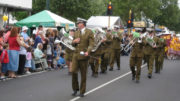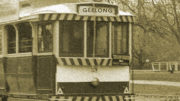Kinnear’s Ropeworks or M. Donaghy and Sons Fairview Ropeworks as it was earlier know, was a huge industrial site towards the northern end of Pakington Street in West Geelong. The factory had made rope on the site from 1874 until its close in the 1980’s

The factory was established by Irishman Michael Donaghy. Donaghy learn the art of ropemaking in England before coming to Australia. Donaghy started the rope making business in Marnock Vale near Riversdale Road in 1853 in an area we know today as Chillwell or Newtown. Donaghy soon outgrew his first factory and he decided to invest in a larger factory that was closer to the railway line.
The new factory was built in Pakington Street West Geelong in 1873, it was more suitable and was fitted with lots of new technology imported from the UK and USA. Donaghy’s rope business was so busy he also enlisted the help of his sons John and Michael. John eventually took over the company and was once a West Geelong Councillor, represented Geelong in the Legislative Assembly and held many titles and achievements around Geelong in his life time. Rope was in great demand around this time and Donaghy set up other Ropeworks in Port Adelaide and Dunedin, New Zealand.
The factory consisted of a 500 metre rope walk enclosed in a long narrow corrugated iron shed. The walk was used to lay out and create long ropes. Bundles of fibre were spun into strands and then pulled along the rope walk. They are then attached to hooks and twisted and woven to create the rope.
When Donaghy’s business went into recievership the working factory was sold to one time rival ropemaker Kinnears in 1978. Kinnears continued rope making operations on the site up until 1999. Modern technology and cheaper rope imports from overseas had finally forced the closure of the 125 year old factory.
Today the ropeworks site after many years of controversy has fallen to the developer and is now a new shopping centre called Pakington Strand. This new complex opened in 2009 and contains Woolworths as its major tenant and a range of smaller specialty stores. While much of the former factory was demolished, the former canteen building and the heritage listed ropewalk was retained as part of the redevelopment. The developers had originally had a small section of the ropewalk building open with a small museum of old rope making equipment on display but this attraction was closed and the windows into the building has now been painted over.

The majority of the ropewalk extended up between residential housing, its long skinny building was quite unique and made an impact on the size of the house blocks that surrounded it. The only evidence of its existence was some parts of the corrugated iron building visible from 3 short lanes running off Collins Street. In early 2017 after years of neglect and vandalism an emergency order to demolish the ropewalk saw the historic long skinny section of the building demolished. As of 2018 it looks like the vacant land that once housed the three metres wide and four hundred metres long ropewalk shed is set to be carved up into long skinny blocks and sold off for housing.




